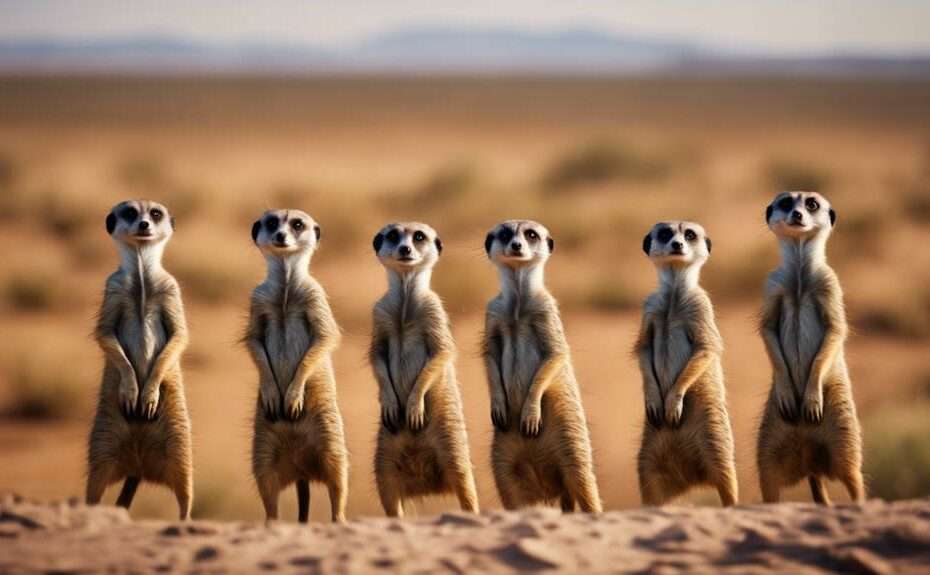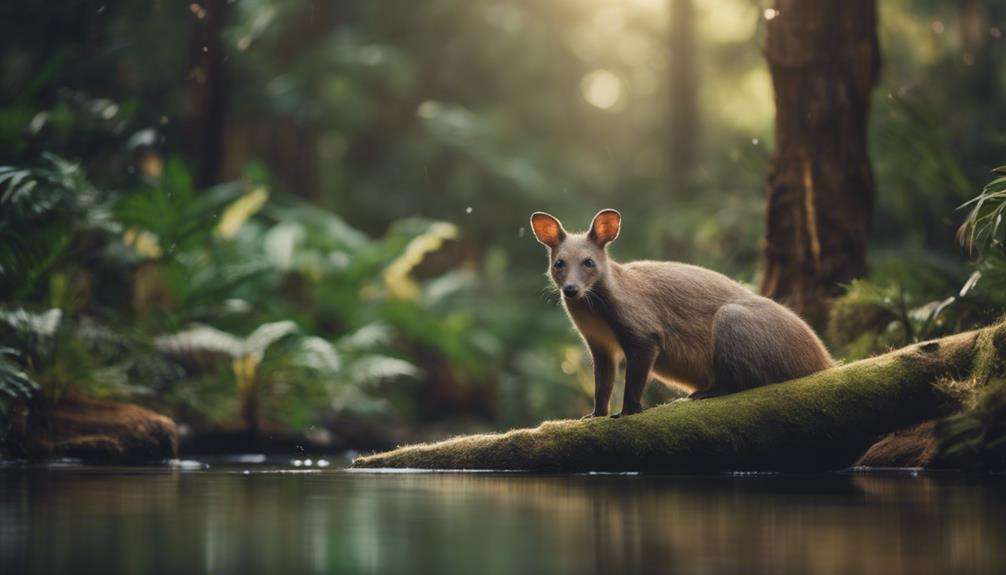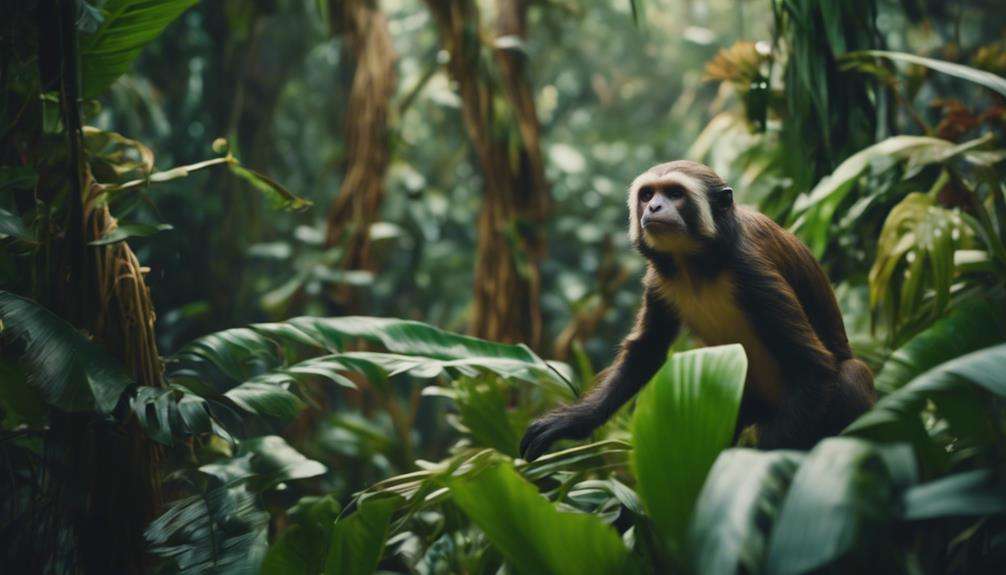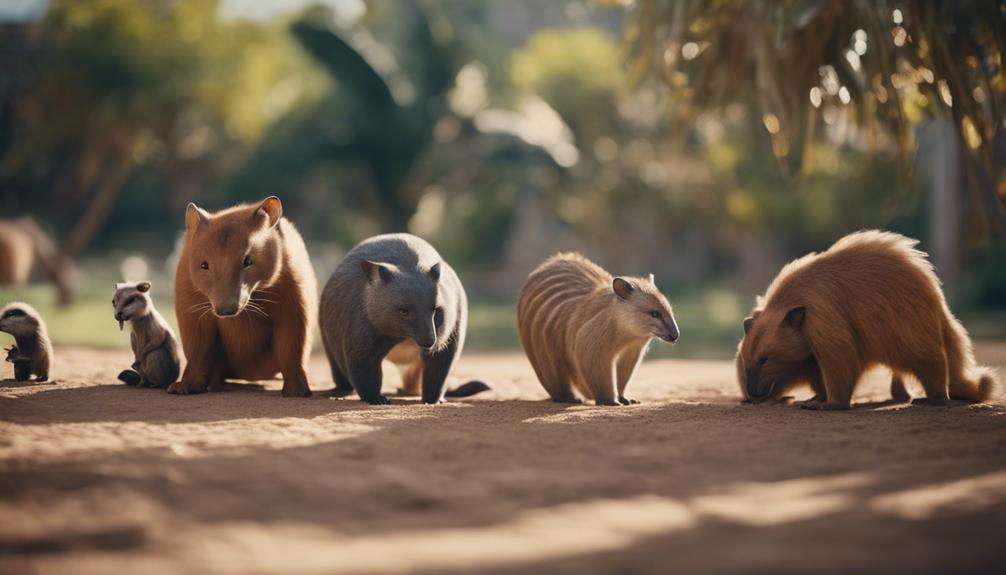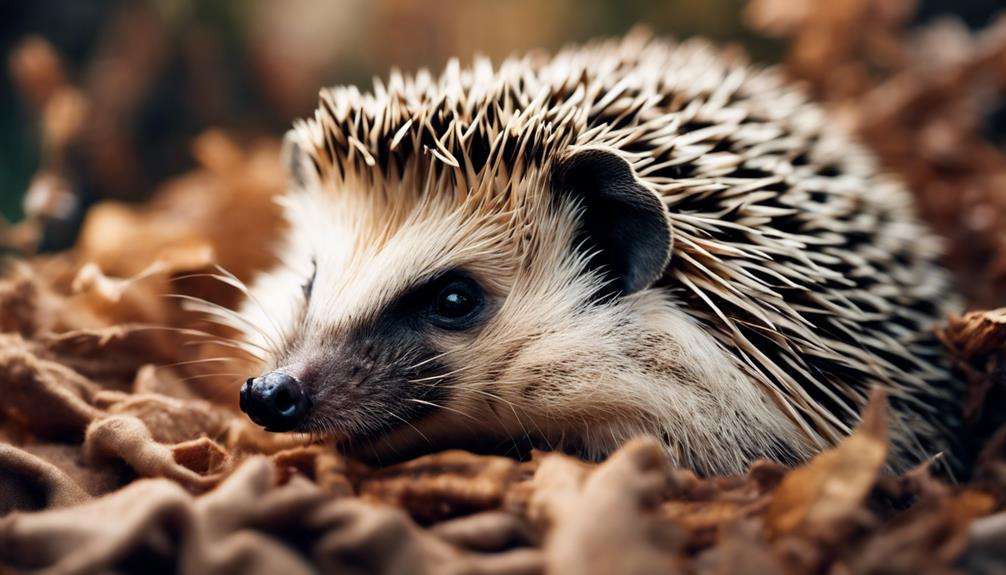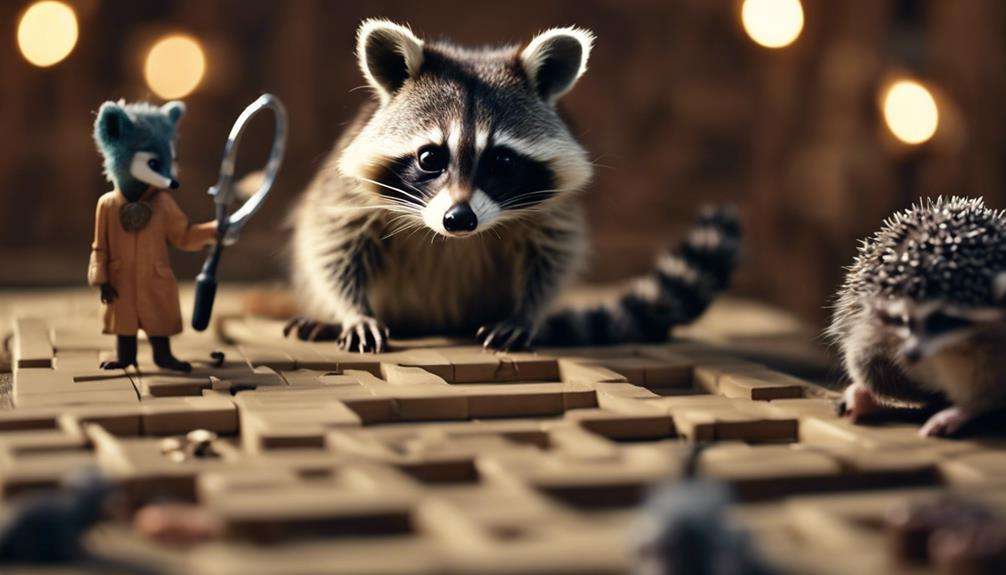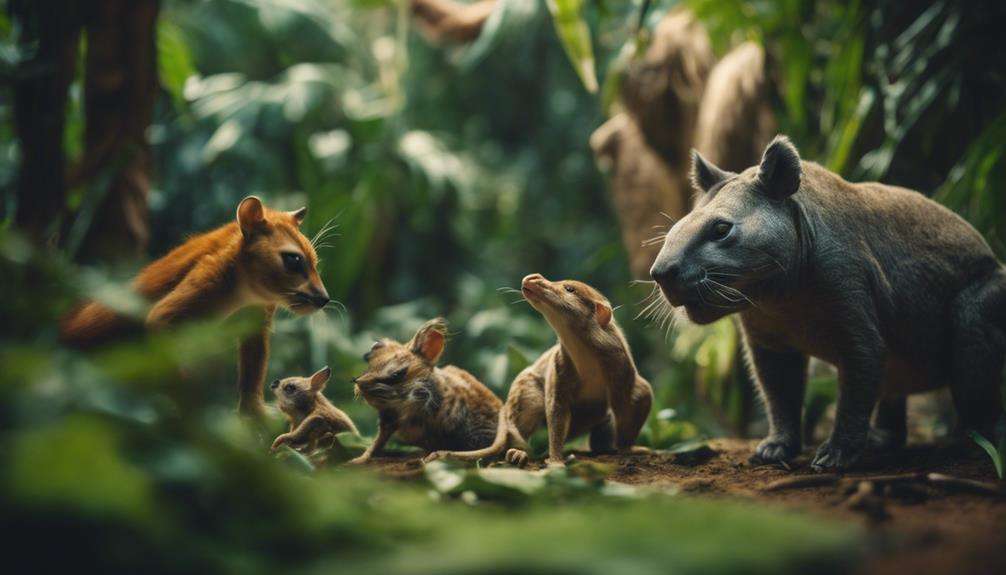You might find it interesting to explore the intriguing social dynamics of seven unique mammal species that demonstrate remarkable levels of cooperation and communication within their groups.
From the intricate family structures of meerkats to the peaceful and sociable nature of bonobos, each species offers a glimpse into the fascinating world of social animals.
As you delve into the lives of these mammals, you'll discover how their interactions provide insights into the complexities of social behavior and the benefits it brings to their communities.
Key Takeaways
- Social mammals exhibit intricate social structures and behaviors.
- Unique social behaviors contribute to group success and survival.
- Social bonds are crucial for cooperation, communication, and species survival.
- Wildlife social structures offer valuable insights into unity, teamwork, and adaptation.
Orangutans: Masters of Social Bonding
Why are orangutans considered masters of social bonding among primates?
Orangutans, as social animals, excel in forming intricate social connections, especially evident in the strong maternal bonds they cultivate. These primates showcase a remarkable communication system comprising a wide array of facial expressions, gestures, and vocalizations, essential for maintaining their social relationships within the group.
Furthermore, orangutans display a high level of intelligence by using tools in their social interactions, like utilizing sticks to extract insects for food, showcasing their adaptive behaviors. Their social dynamics also reveal a deep sense of empathy and cooperation, highlighting the complexity of their social interactions.
Additionally, the slow reproductive rate of orangutans, with females giving birth to a single offspring every 6-8 years, underscores the critical role of social bonds in their species' survival and success.
In essence, orangutans stand out as masters of social bonding among primates due to their intricate social behaviors and strong emotional connections within their groups.
Meerkats: Tight-Knit Family Dynamics
Meerkats, renowned for their tight-knit family dynamics, live in cohesive groups known as mobs, where up to 30 individuals collaborate in various social behaviors. Social cooperation is a hallmark of meerkat society, with members taking on specialized roles for the benefit of the group. One striking behavior is their system of sentry duty, where individuals rotate positions to keep a lookout for predators while the rest forage for food. Through a combination of vocalizations and body language, meerkats effectively communicate within the group, coordinating activities and maintaining group cohesion.
Communal care is another key aspect of meerkat social dynamics. All mob members participate in raising and protecting the young pups, showcasing a high level of cooperation and shared responsibility. Their social structure is hierarchical, with dominant individuals guiding group decisions and subordinate members following their lead. This intricate system of leadership and collaboration ensures the survival and success of the meerkat mob in the challenging African savannah environment.
Bonobos: Peaceful and Sociable Primates
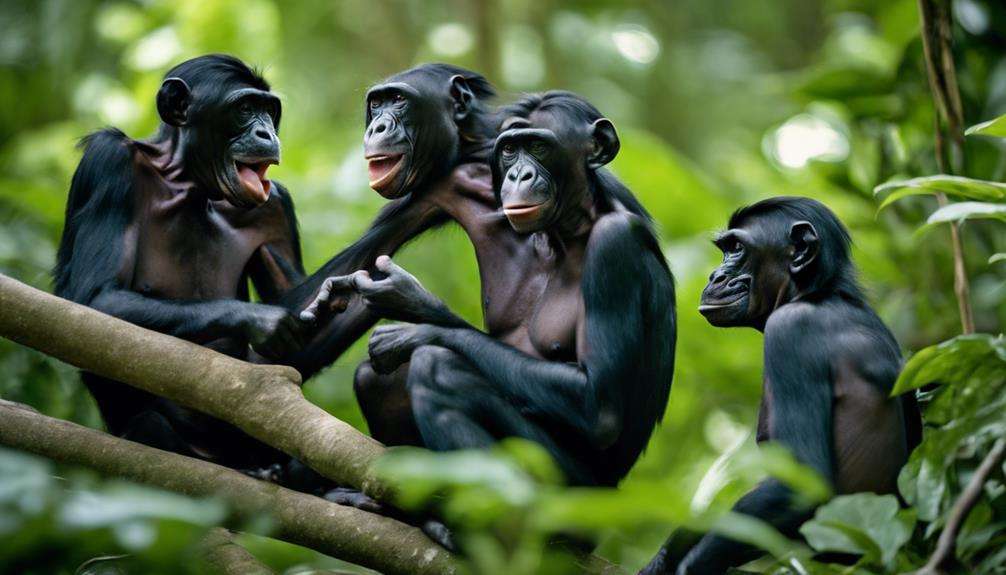
Bonobos, highly social primates, exhibit fascinating behaviors within their communities.
Their peaceful and egalitarian social structure highlights the importance of cooperation and social harmony.
Through unique methods like using sex for conflict resolution, bonobos maintain cohesive relationships within their groups.
Bonobo Behavior Insights
Peaceful and sociable, bonobos, also known as 'hippie apes,' exhibit remarkable social behaviors characterized by harmonious interactions and unique conflict resolution strategies. These social creatures display fascinating insights into their behavior:
- Conflict Resolution: Bonobos utilize sexual activities to resolve conflicts, fostering bonding and reducing tension within their communities.
- Matriarchal Social Structure: Females play pivotal roles in decision-making and maintaining group cohesion in bonobo societies.
- Empathy and Cooperation: Bonobos demonstrate high levels of empathy, cooperation, and social play, emphasizing their strong social bonds.
- Grooming Rituals: Grooming rituals among bonobos strengthen relationships, reduce stress, and establish trust among group members.
Social Interactions Among Bonobos
With their intricate social dynamics and cooperative behaviors, bonobos exemplify a fascinating case study in primate sociology and communication. Female bonobos play a pivotal role in maintaining group cohesion through their influential positions within the matriarchal society.
These peaceful primates rely on social interactions like grooming and sexual activities to resolve conflicts and strengthen bonds. Vocalizations, facial expressions, and body language are key components of their communication repertoire, enabling them to convey complex emotions and reinforce social connections.
Empathy, altruism, and social intelligence are prevalent among bonobos, contributing to the formation of strong relationships and alliances that underpin the harmonious and cooperative nature of their communities.
Through their intricate social interactions, bonobos showcase the significance of group cohesion in sustaining their peaceful and sociable societies.
Naked Mole Rats: Unique Social Structures
Naked mole rats, through their intricate social organization, exemplify a remarkable adaptation to underground living environments. These creatures have evolved unique social structures that set them apart from other mammals:
- Eusocial Behavior: Naked mole rats live in underground colonies reminiscent of insect societies, with a queen, workers, and soldiers. This eusocial system involves specialized roles and cooperative behavior for the survival of the entire colony.
- Extreme Sociality: They're the only known eusocial mammals, displaying extreme social behavior where sterile worker rats care for the queen's offspring. This high level of cooperation is crucial for the colony's success.
- Communication Methods: These mammals communicate through a combination of complex vocalizations, tactile signals, and pheromones within their close-knit communities. This sophisticated communication network helps maintain order and cohesion within the colony.
- Highly Organized Structure: Naked mole rats have a highly organized social structure that enables them to thrive in the challenging conditions of underground environments. This structured system contributes to their remarkable ability to adapt and thrive in subterranean habitats.
African Wild Dogs: Cooperative Hunting Strategies
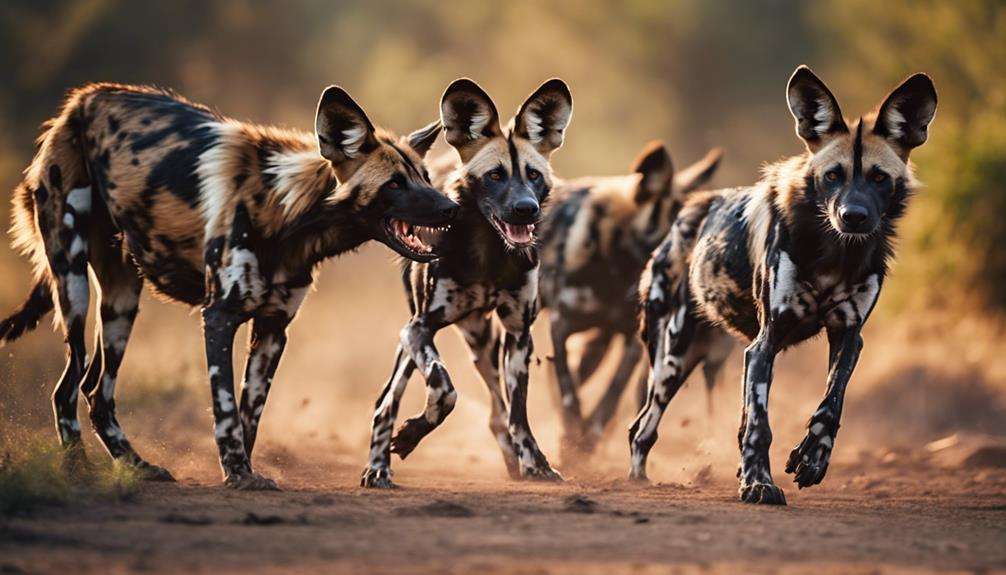
African wild dogs, scientifically known as Lycaon pictus, exhibit fascinating cooperative hunting strategies within their packs.
These social mammals engage in intricate hunting pack dynamics, coordinating strategic prey ambushes to secure successful kills.
Their teamwork and communication skills during hunts are essential for the pack's survival and hunting success.
Hunting Pack Dynamics
Cooperatively hunting in packs, painted wolves, also known as African wild dogs, exhibit intricate strategies that rely on coordinated teamwork to increase hunting success rates. These social mammals have evolved a sophisticated system for hunting that involves various roles and responsibilities within the pack:
- Strategic Positioning: African wild dogs strategically position themselves around the targeted prey to create an effective hunting formation.
- Communication Through Vocalizations: They use a range of vocalizations to communicate during the hunt, signaling to each other and coordinating their movements.
- Coordinated Chase: The pack works together to chase down prey, utilizing their speed and endurance to outlast their target.
- Specialized Roles: Each pack member has a specific role during the hunt, contributing to the overall success of the cooperative hunting strategy.
Strategic Prey Ambushes
How do painted wolves execute strategic prey ambushes to ensure successful cooperative hunting endeavors?
African wild dogs, renowned for their cooperative hunting tactics, meticulously plan and execute their prey ambushes. When hunting in packs, these social mammals coordinate their movements, strategically encircling their target to cut off escape routes. Alpha and beta individuals within the pack take on leadership roles, guiding the group with precision and efficiency. Through synchronized teamwork, African wild dogs create confusion among their prey, leading to successful ambushes.
This cooperative hunting strategy not only highlights their exceptional hunting skills but also emphasizes the importance of unity within the pack. By working together seamlessly, African wild dogs maximize their chances of capturing prey, showcasing the remarkable collaborative nature of these fascinating social mammals.
Bats: Social Communication Through Echolocation
Have you ever considered how bats utilize echolocation for social communication within their colonies? Bats emit high-frequency sounds and listen to the echoes that bounce back, allowing them to navigate and interact with their fellow colony members. Here are some fascinating insights into how bats use echolocation for social communication:
- Navigation and Coordination: Echolocation helps bats navigate their surroundings and coordinate group activities such as foraging and roosting. By communicating through these calls, bats can stay connected and move as a cohesive unit within their colonies.
- Identifying Individuals: The unique echolocation calls of each bat species enable individuals to recognize one another within the colony. This identification is crucial for maintaining social bonds and group cohesion.
- Locating Food: Bats use echolocation not only to communicate with each other but also to locate food sources. Sharing information about food locations through these calls benefits the entire colony.
- Enhancing Survival: Social communication through echolocation plays a vital role in enhancing the survival of bat colonies. It helps them avoid predators, find shelter, and thrive in their shared environment.
Red Foxes: Complex Social Hierarchies
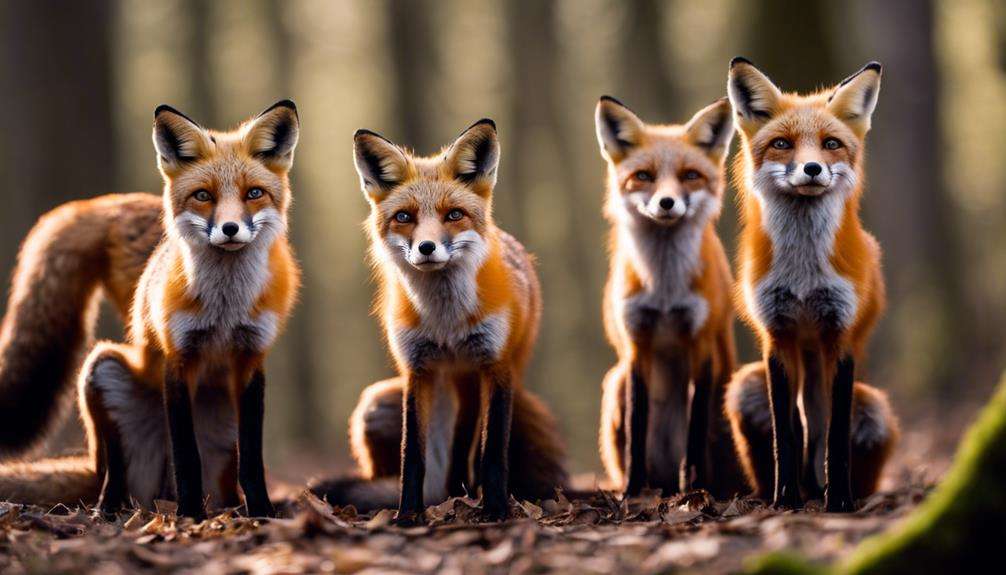
Red foxes, unlike bats that rely on echolocation for social communication, exhibit intricate social hierarchies within their small family groups led by dominant male and female pairs. They live in large groups where subordinate foxes play a crucial role in helping raise the offspring of the dominant pair. Communication among red foxes is a sophisticated affair, involving vocalizations, body language, and scent marking to maintain social bonds within the community.
Young red foxes spend their initial months with their families, engaging in playful behaviors, grooming one another, and participating in social interactions. These interactions not only strengthen social bonds but also help establish the hierarchy within the group. Interestingly, as the young foxes mature, they disperse to find their territories, contributing to the genetic diversity and expansion of red fox populations.
Through their complex social structures and interactions, red foxes demonstrate the significance of cooperation and communication in maintaining their family units and ensuring the survival of their species.
Frequently Asked Questions
Which Mammals Are the Most Social?
Elephants, meerkats, dolphins, chimpanzees, and wolves showcase remarkable social behaviors. They establish intricate social hierarchies within their groups, displaying cooperation, communication, and communal activities. These fascinating mammals exemplify the importance of social bonds in their respective communities.
What Are the Most Complex Social Animals?
In the realm of animal behavior, certain species exhibit remarkable complexity in their social dynamics. From intricate communication systems to cooperative strategies, these creatures engage in elaborate interactions that shape their group cohesion and survival.
Which Animals Are Highly Social?
Elephant herds showcase intricate social dynamics, with matriarchs leading and fostering relationships within the group. These majestic creatures prioritize cooperation and communication, forming a tight-knit community that supports each other for survival and well-being.
What Animals Love to Socialize?
You observe various animals engaging in social bonding, showcasing intricate behaviors for socializing. Elephants, meerkats, dolphins, chimpanzees, and wolves display a deep love for social interactions, forming tight-knit communities that emphasize their need for connection and cooperation.
Conclusion
You can't help but marvel at the intricate social structures and behaviors exhibited by these fascinating social mammals.
From the masterful social bonding of orangutans to the tight-knit family dynamics of meerkats, each species showcases remarkable cooperation and communication.
The complexity of their interactions is truly astounding, highlighting the incredible depth of social behavior in the animal kingdom.
Witnessing these creatures in action is a testament to the power of social connections in shaping their lives and survival strategies.
